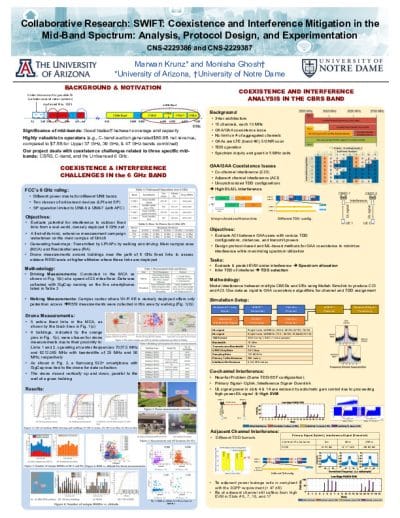Authors
Marwan Krunz and Monisha Ghosh
Abstract
This poster provides an update on the PIs' progress on the SWIFT project, focusing on coexistence in the unlicensed 6 GHz bands and on Tier-3 coexistence in the CBRS band. Mid-bands exhibit favorable propagation characteristics that enable wide-area coverage at high data rates. They have been only recently allocated for commercial (cellular and WLAN) wireless systems, which will have to coexist on these bands with a wide variety of incumbents, e.g., Navy radar in 3.55–3.7 GHz CBRS band, point-to-point microwave links and passive radioastronomy receivers (e.g., the Methanol line) in the 6 GHz UNII bands, and adjacent radar altimeters in the 4.2–4.4 GHz band. In addition, the emergence of new business models, e.g., private 5G networks, where deployments are controlled by different, unsynchronized operators have given rise to new coexistence issues. 5G operators must coexist with each other across the 3 GHz band under different power allocations and without guard bands. Adjacent and co-channel interference is doomed to occur due to asynchronous transmissions arising from the use of different TDD (Time Division Duplex) uplink/downlink splits. At the same time, 5G operators will have to coexist with Wi-Fi over the unlicensed 6 GHz band. Deployments in these bands are less than two years old, and a number of coex- istence and interference challenges are just beginning to emerge. Our research tackles the technical challenges associated with sharing the above-mentioned bands and developing novel solutions for homogeneous (same technology) as well as heterogeneous coexistence of various systems that are envisioned to operate over these bands, thus maximizing spectral utilization.

